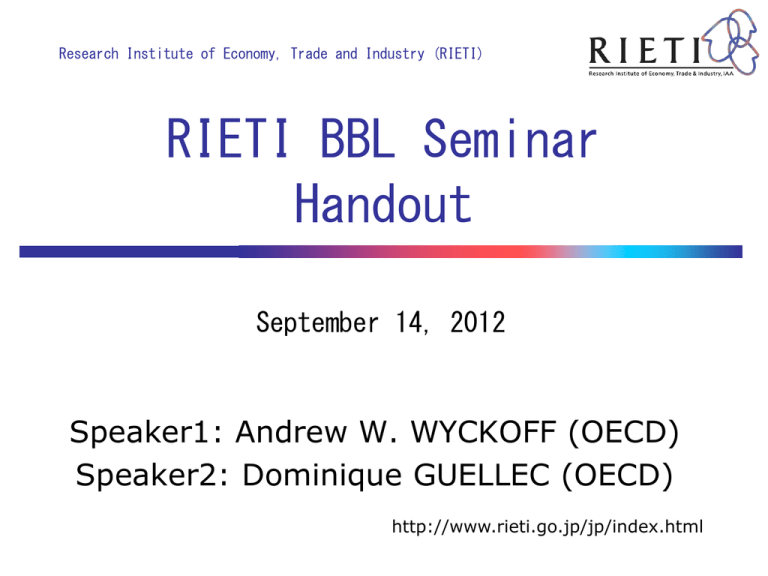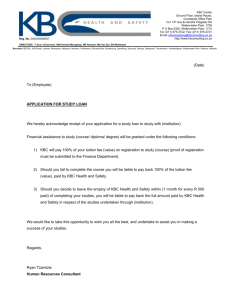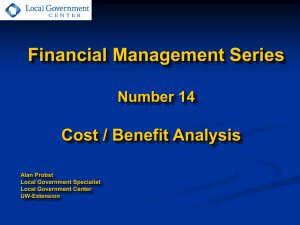RIETI BBL Seminar Handout Speaker1: Andrew W. WYCKOFF (OECD)
advertisement

Research Institute of Economy, Trade and Industry (RIETI) RIETI BBL Seminar Handout September 14, 2012 Speaker1: Andrew W. WYCKOFF (OECD) Speaker2: Dominique GUELLEC (OECD) http://www.rieti.go.jp/jp/index.html Exploiting Global-value Chains and Knowledge-Based Capital for Growth Andy Wyckoff – RIETI BBL 14 September 2012 1 Outline of the presentation 1. The role of knowledge-based assets for growth: • What are they and why do they matter? • What are the main policy issues? • What is the OECD doing? 2. Global value chains and competitiveness • What are global value chains • What do we know, what measures do we have? • Improving measurement – trade in value added • Implications for trade policy • Upgrading value chains – policy issues 3. Conclusions and future work What is knowledge-based capital (KBC) ? Three main types of assets being examined Computerised information (software, databases) Innovative property trademarks, designs) (patents, copyrights, Economic competencies (brand equity, firmspecific human capital, business networks, organisational know-how that increases enterprise efficiency, etc.) 3 Investment in KBC is growing in importance Investment in intangible assets as a percentage of GDP Australia Canada France Germany Italy Japan United Kingdom United States % 14 Japan 12 10 8 6 4 2 Source: COINVEST [www.coinvest.org.uk] and research papers, 2009. 2006 2005 2004 2003 2002 2001 2000 1999 1998 1997 1996 1995 1994 1993 1992 1991 1990 1989 1988 1987 1986 1985 1984 1983 1982 1981 1980 1979 1978 1977 1976 1975 0 And rising in importance compared to tangible assets U.S. non-farm business investment in KBC and tangible assets (% output) 16% 14% tangible investment 12% 10% 8% 6% Investment in KBC 4% 2% 0% 5 Source: Corrado and Hulten (2010) KBC accounts for over half of all business investment in several countries … Business investment in KBC and tangible assets as a share of GDP, 2009 25% 20% 15% Tangible 10% KBC 5% 0% Source: Corrado et al (2012, forthcoming) And KBC a driver of productivity growth Contributions to labour productivity growth, 1995-2006, in % % Labour quality Physical capital deepening Multifactor productivity Intangible capital deepening 7 6 5 4 3 2 1 0 -1 -2 Source: Data on intangible investment are based on COINVEST [www.coinvest.org.uk] and research papers, 2009. Why this increased business investment in KBC ? •Rising educational attainment in OECD economies; many products becoming more knowledge intensive. •With globalisation and deregulation, competitive advantage increasingly driven by innovation….in turn driven by investments in intangibles. •New ICTs increase the value of some intangibles to firms. •Growth of the services sector: services rely highly on the use of intangibles. • Fragmentation of value chains – and increasing sophistication of production in many industries – increase the importance of KBC, particularly organisational capital. 8 Why this increased business investment in KBC ? Rising educational attainment in OECD economies. Many becoming more knowledge KBCproducts is based fundamentally onintensive. human capital (skills, knowledge, creativity). With globalisation and deregulation, competitive advantage increasingly driven by innovation….in turn driven by investments in intangibles. New ICTs may itself increase the value of some intangibles to firms. Growth of the services sector, as many service sector firms rely highly on the use of intangibles. Fragmentation of value chains – and increasing sophistication of production in many industries – increase the importance of intangibles, particularly organisational capital. 9 Why this increased business investment in KBC? Rising educational attainment in OECD economies. Many products becoming more knowledge intensive. With globalisation and deregulation, competitive advantage increasingly driven by innovation….in turn driven view by investments in Automotive manufacturers intangibles. leadership in control software as vital Fragmentation of value chains – and increasing sophistication of production in many industries – increase the importance of intangibles, particularly organisational capital. Chevrolet Volt has New ICTs may itself increase the value of some intangibles to firms. 10,000,000 lines of code. Growth of the services sector, as many service sector firms rely highly on the use of intangibles. 10 Why this increased business investment in KBC? Rising educational attainment in OECD economies. Many products becoming more knowledge intensive. With globalisation and deregulation, competitive advantage increasingly driven by innovation….in turn driven by investments in Approx 40% of development costs Automotive manufacturers view in cars today intangibles. in control software as vital are softwareleadership and electronics related. Fragmentation of value chains – and increasing sophistication of production in many industries – increase the importance of intangibles, particularly organisational capital.Chevrolet Volt has 10,000,000 lines of code. New ICTs may itself increase the value of some intangibles to firms. Growth of the services sector, as many service sector firms rely highly on the use of intangibles. 11 Why this increased business investment in KBC? “Our clothes are Italian, French and German, so the profits Rising attainment in create OECD brands, economies. are all educational leaving China…We need to and fast”. SG, China Industrial Overseas Many products becoming more knowledge Development and Planning Assoc. intensive. With globalisation and deregulation, competitive advantage increasingly driven by innovation….in turn driven by investments in intangibles…and not just R&D. New ICTs may itself increase the value of some firms. E.g.intangibles patentable to technology is only about 25% of the Growth of the services sector, as many service value sectoroffirms rely highly the iPhone on the use of intangibles. (Korkeamaki and Takalo (2010) Fragmentation of value chains – and increasing sophistication of production in many industries – increase the importance of intangibles, particularly organisational capital. 12 Why this increased business investment in KBC? Rising educational attainment in OECD economies. Many products becoming more knowledge intensive. With globalisation and deregulation, competitive advantage increasingly driven by innovation….in turn driven by investments in intangibles...and not just R&D. New ICTs may itself increase the value of some intangibles to firms. 99%services of the time, at least one Internet Growth of the sector, as many service bookseller sector firms rely highly a lower price than Amazon ! But Amazon on the use ofoffers intangibles. retains a large market share due to reputation for customer Fragmentation of valueservice. chains – and increasing sophistication of (Brynjolfsson and Smith, 2000). the importance of intangibles, production in many industries – increase particularly organisational capital. 13 Why this increased business investment in KBC? Rising educational attainment in OECD economies. Many products becoming more knowledge intensive. With globalisation and deregulation, competitive advantage increasingly driven by innovation….in turn driven by investments in intangibles...and not just R&D. New ICTs may itself increase the value of some intangibles to firms. Growth of the services sector, as many service sector firms rely highly on the use of intangibles. Fragmentation of value chains – and increasing sophistication of production in many industries – increase the importance of intangibles, E.g. Wal-Mart’s computerised particularly organisational capital. supply chains; Merck’s multiple R&D alliances; 100s of subcontractors 14 in aerospace. Some of the key policy issues? Redefining “framework” conditions • Tax • Competition • Property Rights • Finance • Skills • Corporate Accounting The rise of Global Value Chains: what? • International production networks; dispersion of production stages across countries and corresponding (intra-industry trade) • Networks of activities, firms (MNEs and local firms), industries and countries • Reallocation of resources across a growing number of countries: e.g. low skilled labor • More specialisation, complex production relationships, profound changes in countries’ competitiveness • Global flows of goods (final and inputs), services, capital, people, technology… Airline industry: Boeing 787 Dreamliner Wing box: Mitsubishi Heavy Industries (Japan) Wing ice protection: GKN Aerospace (UK) Centre fuselage: Alenia Aeronautica (Italy) Escape slides: Air Cruisers (USA) Rear fuselage: Boeing South Carolina (USA) Vertical Stabiliser: Boeing Commercial Airplanes (USA) Forward fuselage: Kawasaki Heavy Industries (Japan) Spirit Aerosystems (USA) Lavatories: Jamco (Japan) Doors & windows: Zodiac Aerospace (USA) PPG Aerospace (USA) Flight deck seats: Ipeco (UK) Raked wing tips: Korean Airlines Aerospace division (Korea) Horizontal Stabiliser: Alenia Aeronautica (Italy) Centre wing box: Fuji Heavy Industries (Japan) Aux. power unit: Hamilton Sundstrand (USA) Passenger doors: Latécoère Aéroservices (France) Cargo doors: Saab (Sweden) Prepreg composites: Toray (Japan) Landing gear: Messier-Dowti (France) Electric brakes: Messier-Bugatti (France) Tires: Bridgestone Tires (Japan) Source: www.newairplane.com Engines: GE Engines (USA), Rolls Royce (UK) Engine nacelles: Goodrich (USA) Tools/Software: Dassault Systemes (France) Navigation: Honeywell (USA) Pilot control system: Rockwell Colins (USA) Wiring: Safran (France) Final assembly: Boeing Commercial Airplanes (USA) Automotive industry: Renault Clio 18 Toys: Barbie doll Design: California, USA Nylon hair: Japan Body material: Chinese Taipei Moulds, paint pigments: USA Clothing: China Quality testing: USA Assembly: Indonesia and Malaysia Marketing: USA Source: Grossman and Rossi-Hansberg (2006) Apple’s iPod The Apple iPod = 299$ of Chinese exports to US Distribution of the value added • 299 US$ – 75$ profit to US (Apple) – 73$ whls/retail US (Apple) – 75$ to Japan (Toshiba) – 60$ 400 parts from Asia – 15$ 16 parts from the US – 2$ assembly by China • iTunes Music Store (2003) – 70% digital market share – Platform for everything 20 – Data flow to the consumer Policy issues • GVCs are not a new phenomenon, but the scale, speed and complexity raises several policy issues 5 Policy Issue Areas 1. Measurement of GVCs: Trade in Value Added (TiVA) 2. GVCs and trade policy 3. GVCs and national competitiveness… the recurring discussion on industrial policy 4. GVCs and global systemic risk 5. GVCs and upgrading – knowledge based assets 1. Measurement: Issues with current trade statistics • Three issues: 1. Multiple counting of intermediate goods and services 2. Tends to conceal the actual patterns of trade & beneficiaries 3.Incomplete picture as knowledge and income flows are not measured. 22 An alternative measure: Trade in value added (TiVA) • Objectives – Reduce multiple counting of intermediate goods and services – Properly account for the country of origin of each intermediate input – Identify who (country/sectors) contributes to the value chain in terms of income and employment – Foster a closer integration between trade, business, balance of payments statistics and national accounts. • OECD-WTO collaboration – – – – Cooperation with IDE-JETRO, USITC, academic experts, etc. Produce and disseminate trade statistics in value added Promote evidence-based policy making Support and sustain research in the related fields 23 Exported Value-Added: % of Gross Exports 1995 % 100 2009 80 60 40 China Japan Korea Germany Czech Hungary France United United Republic Kingdom States Imports increasingly important in exports, and thus national competitveness (1) Import content of exports, 1995 Source: OECD (2011) Imports increasingly important in exports, and thus national competitveness (2) Import content of exports, 2005 Source: OECD (2011) TiVA: Value-added chains (by product) Germany- automotive China - electronics 27 Foreign content share of China's exports 1995 2005 Services US$ 8 bn Primary US$ 8 bn Services US$ 56 bn Primary US$ 16 bn 6% 9% 4% 4% Higher Tech US$ 57 bn 11% 25% 10% 9% Lower Tech US$ 387 bn Lower Tech US$ 106 bn Foreign Domestic Higher Tech US$ 343 bn Japan’s exports by region, 2009 Export partner share (gross) Export partner share (VA) 19% 26% 19% 22% 14% 21% 14% 18% 27% 20% China OtherAsia Japan United States Europe Rest of World Trade in Services: Gross vs. Value Added % total exports of gross flows % % total exports of value-added Gross flows 1995 Value-added flows 1995 2009 2009 70 60 50 40 30 20 10 0 China United Germany Japan United France States Kingdom Italy Canada Rest of World China United Germany Japan United France States Kingdom Italy Canada Rest of World GVCs and trade policy • Bilateral trade balances misrepresented… ….currency valuations put in new light… … may give rise to trade disputes: who is ‘us’ and who is ‘them’ in a world of GVCs? • Calls into question « anti-dumping » measures and more generally the extra-costs of protectionist policies (import tariffs, rules of origin, etc)… …‘beggar thyself’ instead of ‘beggar thy neighbour’ GVCs and national competitiveness • Imports increasingly important for exports (no mercantilistic approach: ‘exports are good, imports are bad’) • Better understanding the direct link between trade and income & jobs • Better understanding the link between manufacturing and services; • Questions about the link between R&D, design and production. GVCs and upgrading/innovation • Exports and imports are not value added • Being stuck in the middle: value created upstream and downstream – moving up the value chain • Challange for emerging economies: making sure that value ‘sticks’ as developed economies retain value creation • Importance of knowledge based capital A GVC perspective is also important for upgrading, i.e. increasing value creation Old paradigm: From low to high value-added sectors Services Manufacturing New paradigm: From low to high value-added activities within sectors Commodities Services R&D, design Operations 34 Moving up the value chain – capturing more value Value creation along the value chain Source: Presentation G. Gereffi , GVC workshop ‘GVCs and emerging countries’ workshop , Paris (2010) Upgrading is not always a shift to upstream activities but also about strengthening technological capabilities Upgrading path Types of Upgrading Example Process Upgrading Improving the efficiency of internal processes significantly better Hon Hai Precision Industry than rivals (faster processing, lower scrap and defection, higher (World's largest OEM firms ) ability to process complex order (frequent and small batch)) Product Upgrading ASUSTek (inventor of netbook), Introducing new products or improving old products faster than rivals. Developing novel products with highly superior function and Mabuchi Motors (micromotors), Karcher (high-pressure cleaner) quality than that of rivals. Establishing competitiveness in higher value added activities by Functional Upgrading acquisition of new function or moving the locus of activities to different stages in the value chain (ex: from production to R&D) Chain Upgrading Shifting part of or whole activitiy to other value chain rewarding higher value-added Dell, Hewlet-Packard (acquisition of cloud-computing business), Lenovo (acquisition of IBM's R&D capability and brand) Samsung (from flat panel TV to semiconductor to solar cell) 36 What is the OECD doing? Next Steps • Wide-ranging work on GVCs “horizontally” across the OECD. and KBC • KBC Conference planned in February; GVC Workshop in March 2013 • Separate reports to OECD Ministerial in May/June 2013 • Deepening and 2013/2014 further work planned in In sum • Knowledge-based assets: Summing up The nature of investment is changing; the policy agenda still needs to adapt, e.g.: Tax and competition policy IPR policies New opportunities for growth and value creation, e.g. data Measurement a challenge • Global Value Chains: Need to better understand who creates value in trade Can contribute a new trade narrative Upgrading is increasingly linked to specific functions, rather than sectors, and is often based on knowledge-based assets. Requires broad-ranging policy agenda, including trade policy, innovation, skills and structural policy 38






